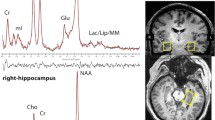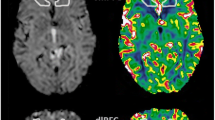Abstract
Despite good neurological outcome after the treatment of ruptured or incidental cerebral aneurysms, many patients complain about mood disturbances such as anxiety and depression. The present study investigated the nature of these affective disorders, their trigger factors, and corresponding structural brain changes. We assessed 63 patients matched by history of previous subarachnoid hemorrhage (SAH) and treatment modality (clipping vs. coiling) by a test battery including the Hospital Anxiety and Depression Scale (HADS) and beck depression inventory-II (BDI-II). MR imaging for the evaluation of structural changes included H1-MR spectroscopy, hippocampal volumetry, and diffusion tensor imaging (DTI). The applied multimodal imaging revealed no significant differences between patients with previous SAH and patients with incidental aneurysms; there were also no substantial differences between patients with and without previous SAH with respect to depression and anxiety. However, we observed significantly higher mean HADS scores in patients treated surgically versus patients treated by coiling (p < 0.01). BDI-II tended to be higher in surgically treated patients, but this difference appeared statistically insignificant. Surgically treated patients displayed substantial hippocampal damage in all imaging techniques: reduction in mean concentrations of N-acetylaspartate (p = 0.04), hippocampal volume reduction (p = 0.012), and diffusion disorder (p = 0.02). The structural alterations correlated significantly with the increased HADS scores. In contrast to endovascular treatment, aneurysm surgery seems to be associated with an increased incidence of mood disorders corresponding to hippocampal neuronal loss, independent of preceding SAH.




Similar content being viewed by others
References
Hop JW, Rinkel GJ, Algra A, van Gijn J (1997) Case-fatality rates and functional outcome after subarachnoid hemorrhage: a systematic review. Stroke 28:660–664 (a journal of cerebral circulation)
Al-Khindi T, Macdonald RL, Schweizer TA (2010) Cognitive and functional outcome after aneurysmal subarachnoid hemorrhage. Stroke 41:e519–e536 (a journal of cerebral circulation)
Beck ATSR, Brown GK (1996) Beck Depression Inventory. San Antonio, The Psychological Corp
Stienen MN, Weisshaupt R, Fandino J, Fung C, Keller E, Hildebrandt G, Studerus-Germann A, Muri R, Gutbrod K, Blasi S, Monsch AU, Brugger P, Mondadori C, Sailer M, Bijlenga P, Schaller K, Schatlo B, on behalf of the Swiss SOSsg (2013) Current practice in neuropsychological outcome reporting after aneurysmal subarachnoid haemorrhage. Acta neurochirurgica
Bendel P, Koivisto T, Hanninen T, Kolehmainen A, Kononen M, Hurskainen H, Pennanen C, Vanninen R (2006) Subarachnoid hemorrhage is followed by temporomesial volume loss: MRI volumetric study. Neurology 67:575–582
Proust F, Martinaud O, Gerardin E, Derrey S, Leveque S, Bioux S, Tollard E, Clavier E, Langlois O, Godefroy O, Hannequin D, Freger P (2009) Quality of life and brain damage after microsurgical clip occlusion or endovascular coil embolization for ruptured anterior communicating artery aneurysms: neuropsychological assessment. J Neurosurg 110:19–29
Maller JJ, Thomson RH, Lewis PM, Rose SE, Pannek K, Fitzgerald PB (2010) Traumatic brain injury, major depression, and diffusion tensor imaging: making connections. Brain Res Rev 64:213–240
Zigmond AS, Snaith RP (1983) The hospital anxiety and depression scale. Acta Psychiatr Scand 67:361–370
Schuff N, Neylan TC, Fox-Bosetti S, Lenoci M, Samuelson KW, Studholme C, Kornak J, Marmar CR, Weiner MW (2008) Abnormal N-acetylaspartate in hippocampus and anterior cingulate in posttraumatic stress disorder. Psychiatry Res 162:147–157
Sapolsky RM (2000) Glucocorticoids and hippocampal atrophy in neuropsychiatric disorders. Arch Gen Psychiatry 57:925–935
Raps EC, Rogers JD, Galetta SL, Solomon RA, Lennihan L, Klebanoff LM, Fink ME (1993) The clinical spectrum of unruptured intracranial aneurysms. Arch Neurol 50:265–268
Bendel P, Koivisto T, Niskanen E, Kononen M, Aikia M, Hanninen T, Koskenkorva P, Vanninen R (2009) Brain atrophy and neuropsychological outcome after treatment of ruptured anterior cerebral artery aneurysms: a voxel-based morphometric study. Neuroradiology 51:711–722
Wang SH, Zhang ZJ, Guo YJ, Teng GJ, Chen BA (2009) Decreased expression of serotonin 1A receptor in the dentate gyrus in association with chronic mild stress: a rat model of post-stroke depression. Psychiatry Res 170:245–251
Kreitschmann-Andermahr I, Poll E, Hutter BO, Reineke A, Kristes S, Gilsbach JM, Saller B (2007) Quality of life and psychiatric sequelae following aneurysmal subarachnoid haemorrhage: does neuroendocrine dysfunction play a role? Clin Endocrinol 66:833–837
von Lehe MM K, Fimmers R, Clusmann H (2011) Comparison of quality of life (QOL) after epilepsy surgery and after clipping of incidental aneurysms. In: 62nd Annual Meeting of the German Society of Neurosurgery (DGNC). Hamburg, Germany
Hadjivassiliou M, Tooth CL, Romanowski CA, Byrne J, Battersby RD, Oxbury S, Crewswell CS, Burkitt E, Stokes NA, Paul C, Mayes AR, Sagar HJ (2001) Aneurysmal SAH: cognitive outcome and structural damage after clipping or coiling. Neurology 56:1672–1677
Peng HJ, Zheng HR, Ning YP, Zhang Y, Shan BC, Zhang L, Yang HC, Liu J, Li ZX, Zhou JS, Zhang ZJ, Li LJ (2013) Abnormalities of cortical-limbic-cerebellar white matter networks may contribute to treatment-resistant depression: a diffusion tensor imaging study. BMC Psychiatry 13:72
Brilstra EH, Rinkel GJ, van der Graaf Y, Sluzewski M, Groen RJ, Lo RT, Tulleken CA (2004) Quality of life after treatment of unruptured intracranial aneurysms by neurosurgical clipping or by embolisation with coils. A prospective, observational study. Cerebrovas Dis 17:44–52
Latimer SF, Wilson FC, McCusker CG, Caldwell SB, Rennie I (2013) Subarachnoid haemorrhage (SAH): long-term cognitive outcome in patients treated with surgical clipping or endovascular coiling. Disabil Rehabil 35:845–850
Aben I, Verhey F, Lousberg R, Lodder J, Honig A (2002) Validity of the beck depression inventory, hospital anxiety and depression scale, SCL-90, and hamilton depression rating scale as screening instruments for depression in stroke patients. Psychosomatics 43:386–393
Glodzik-Sobanska L, Slowik A, McHugh P, Sobiecka B, Kozub J, Rich KE, Urbanik A, Szczudlik A (2006) Single voxel proton magnetic resonance spectroscopy in post-stroke depression. Psychiatry Res 148:111–120
Provencher SW (1993) Estimation of metabolite concentrations from localized in vivo proton NMR spectra. Magnetic Reson Med 30:672–679 (official journal of the Society of Magnetic Resonance in Medicine/Society of Magnetic Resonance in Medicine)
Fang J, Cheng Q (2009) Etiological mechanisms of post-stroke depression: a review. Neurol Res 31:904–909
Frazer D, Ahuja A, Watkins L, Cipolotti L (2007) Coiling versus clipping for the treatment of aneurysmal subarachnoid hemorrhage: a longitudinal investigation into cognitive outcome. Neurosurgery 60:434–441 (discussion 441–432)
Gabaldon L, Fuentes B, Frank-Garcia A, Diez-Tejedor E (2007) Poststroke depression: importance of its detection and treatment. Cerebrovasc Dis 24(Suppl 1):181–188
Paolucci S (2008) Epidemiology and treatment of post-stroke depression. Neuropsyc Dis Treat 4:145–154
Hutter BO, Gilsbach JM, Kreitschmann I (1995) Quality of life and cognitive deficits after subarachnoid haemorrhage. Br J Neurosurg 9:465–475
Orbo M, Waterloo K, Egge A, Isaksen J, Ingebrigtsen T, Romner B (2008) Predictors for cognitive impairment one year after surgery for aneurysmal subarachnoid hemorrhage. J Neurol 255:1770–1776
Chen MC, Hamilton JP, Gotlib IH (2010) Decreased hippocampal volume in healthy girls at risk of depression. Arch Gen Psychiatry 67:270–276
Powell J, Kitchen N, Heslin J, Greenwood R (2002) Psychosocial outcomes at three and nine months after good neurological recovery from aneurysmal subarachnoid haemorrhage: predictors and prognosis. J Neurol Neurosurg Psychiatry 72:772–781
Hackett ML, Anderson CS (2000) Health outcomes 1 year after subarachnoid hemorrhage: an international population-based study. The Australian Cooperative Research on Subarachnoid Hemorrhage Study Group. Neurology 55:658–662
Hedlund M, Zetterling M, Ronne-Engstrom E, Carlsson M, Ekselius L (2011) Depression and post-traumatic stress disorder after aneurysmal subarachnoid haemorrhage in relation to lifetime psychiatric morbidity. Br J Neurosurg 25:693–700
Kreiter KT, Rosengart AJ, Claassen J, Fitzsimmons BF, Peery S, Du YE, Connolly ES, Mayer SA (2013) Depressed mood and quality of life after subarachnoid hemorrhage. J Neurol Sci 335:64–71
Morris PG, Wilson JT, Dunn L (2004) Anxiety and depression after spontaneous subarachnoid hemorrhage. Neurosurgery 54:47–52 (discussion 52–44)
Sims A, Sims D (1998) The phenomenology of post-traumatic stress disorder. A symptomatic study of 70 victims of psychological trauma. Psychopathology 31:96–112
Bremner JD, Narayan M, Anderson ER, Staib LH, Miller HL, Charney DS (2000) Hippocampal volume reduction in major depression. Am J Psychiatry 157:115–118
Ebisu T, Rooney WD, Graham SH, Weiner MW, Maudsley AA (1994) N-acetylaspartate as an in vivo marker of neuronal viability in kainate-induced status epilepticus: 1H magnetic resonance spectroscopic imaging. J Cereb Blood Flow Metab 14:373–382 (official journal of the International Society of Cerebral Blood Flow and Metabolism)
Conflicts of interests
The authors declare that they have no conflict of interest.
Ethical standard
The present study received approval from the ethics commitee of the Technical University of Munich and has therefore been performed in accordance with the ethical standards laid down in the 1964 Declaration of Helsinki. All patients gave appropriate informed consent.
Author information
Authors and Affiliations
Corresponding author
Additional information
Maria Wostrack and Benjamin Friedrich contributed equally to this work.
Rights and permissions
About this article
Cite this article
Wostrack, M., Friedrich, B., Hammer, K. et al. Hippocampal damage and affective disorders after treatment of cerebral aneurysms. J Neurol 261, 2128–2135 (2014). https://doi.org/10.1007/s00415-014-7464-y
Received:
Revised:
Accepted:
Published:
Issue Date:
DOI: https://doi.org/10.1007/s00415-014-7464-y




